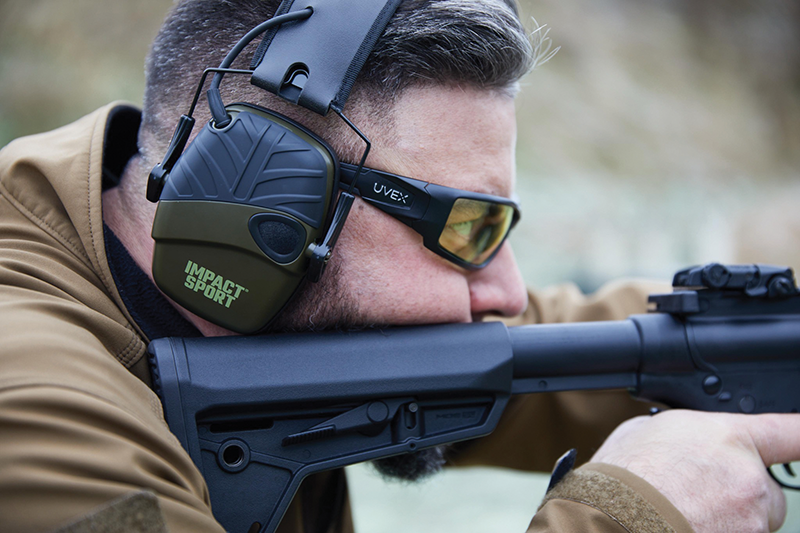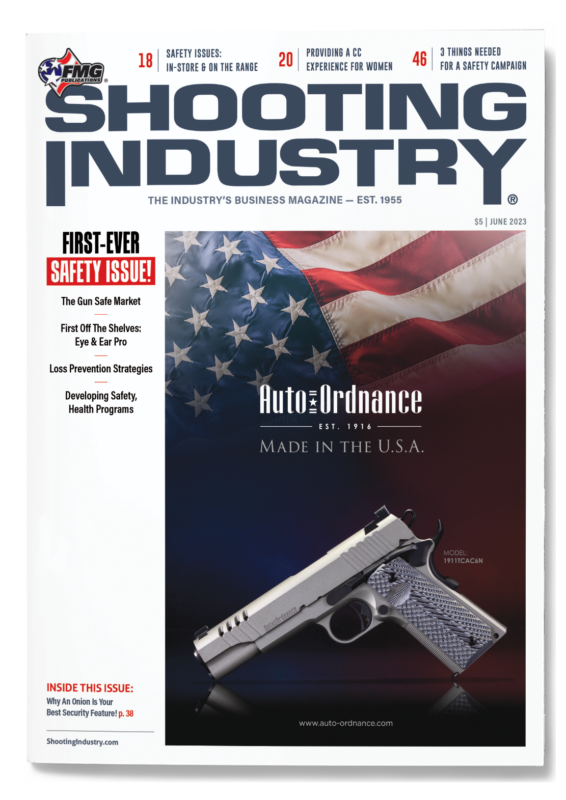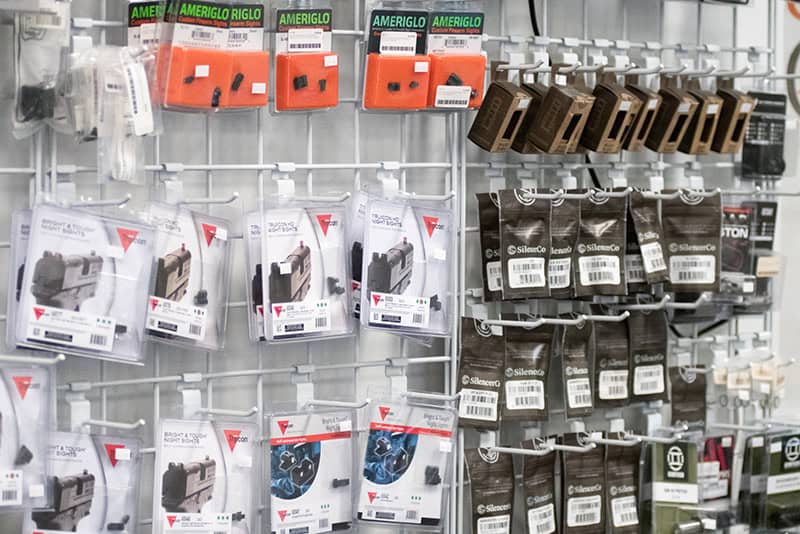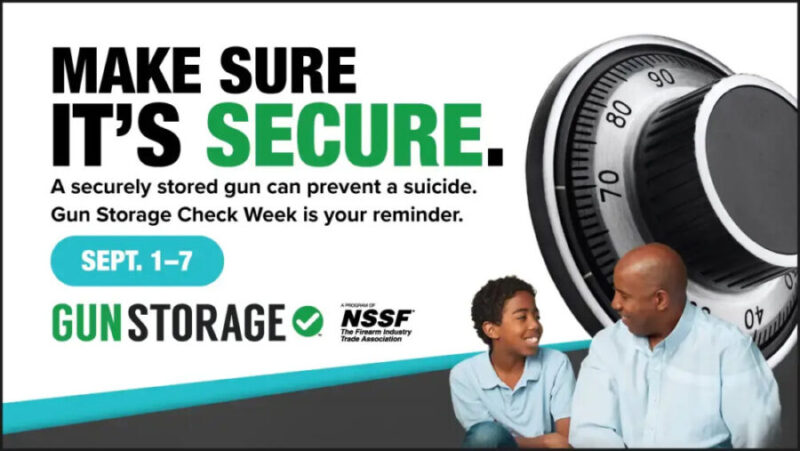First Off The Shelves: Eye & Ear Protection
What Sells? What Doesn’t?
If you were looking to name something in the shop that essentially moves itself off the shelves, you would be hard-pressed to come up with something better than eye and ear protection.
Anytime someone comes in to buy a gun, this safety gear is going to be among the first things you point them to. The same goes for any of your regular range customers who tend to rent or borrow their eye and ear protection.
“Out of all the stuff in the shop, they’re probably the easiest things to sell, maybe other than ammo,” confirmed Tim Van Leiden, owner of The Gun Guys in Ottawa, Kan.
Indeed, this stuff is pretty much a mandatory part of every shooter’s kit, suggests John Stephenson, general manager of Metro Shooting Supplies in Bridgeton, Mo. And that makes it part of his shop’s standard rundown when promoting things to customers.
“‘You just bought this new gun? So now you need a range bag. How about a rag to wipe down your gun after shooting? And let’s get your own eye and ear protection.’ That’s what we try and get them to do — and we’re very successful at it,” he said.
This is true, even though Metro’s range fees include complimentary eye and ear protection. If someone is a regular range user, a Metro staff member will urge them to consider buying their own safety gear.
Stephenson shared, “I tell them it’s like going bowling: How many times do you want to put somebody else’s shoes on your feet?”
Safety gear also makes nice impulse purchases for more established customers. You can make it more of a factor if you carry eye-catching options, according to Dave Neely, purchasing manager for Centennial Gun Club in Centennial, Colo.
For Centennial, this means carrying a wide range of colors and patterns of earmuffs (Howard Leight is a favorite).
“It’s amazing how well they do, even with the special editions and colors that are more expensive,” he stated. “You throw an American flag pattern on the side of earmuffs and people jump all over that type of stuff.”
So, everyone needs eye and ear protection. But what sells and what doesn’t?
“You just bought this new gun? So now you need a range bag. How about a rag to wipe down your gun after shooting? And let’s get your own eye and ear protection.’ That’s what we try and get them to do — and we’re very successful at it.”
John Stephenson, General Manager
Metro Shooting Supplies • Bridgeton, MO.
Eye Protection
For all three of these stores — each with an indoor range — there is a steady demand for shooting glasses. There are limits, however, to how much customers want to pay.
Centennial carries several brands, including Honeywell/Howard Leight, Champion and Peltor. None of them cost more than $10. Still, the mix includes popular features such as clear, amber and dark lenses.
“We even sell the over-the-eyeglass ones, which are always surprisingly popular,” Neely noted.
It’s a similar situation at Metro Shooting Supplies, where customers often gravitate toward the less expensive options for $6.
“They do scratch easily and things like that, but if you take relatively good care of them, they’re going to last a long time,” Stephenson rationalized.
This is fine for the vast majority of customers drawn in by the indoor range. They don’t tend to be interested in paying $100 or more for the types of glasses favored by competitive shooters and hunters.
“We do kind of push people toward an amber or a yellow lens, simply because the higher contrast makes it a little easier to see their sights in these lower light conditions,” he expressed. “We used to carry some of the higher-end stuff, but we found it sat on the shelves forever. By the time somebody bought it, you couldn’t even get replacement lenses.”
There’s a similar buying trend at The Gun Guys, in Kansas, where customers lean toward lower-priced options from Radians and 3M Peltor.
Still, they do offer some higher-priced options from Magpul, Oakley and Wiley X. Those just don’t tend to sell very quickly.
“If customers are going to spend a lot of money on high-end glasses, it’s usually prescription glasses,” Van Leiden maintained. “And we’re not eye doctors, obviously.”
Ear Protection
It’s a different story when it comes to hearing protection. All three stores have found customers are more willing to pay up for pricier options, including those with electronics and Bluetooth features.
Exposure to an indoor range may be a significant factor in those purchasing decisions, suggests Van Leiden. After customers experience how loud the range can be, they often consider a set of strong earmuffs.
“Then they realize if you get good enough earmuffs, you can’t really hear anything,” he conveyed. “So, they try the electronics. That way they can hear well enough to be able to talk to whoever else is in there.”
The store offers options ranging from 50-cent foam plugs on up to electronic earmuffs for around $200. Popular brands include Walker’s and Caldwell. The sweet spot is in the $70 range, which gets a decent set of electronic muffs.
Colorado’s Centennial Gun Club offers a similar selection, with Peltor topping out the range at $200. That’s not the number-one choice for customers, but it does have enough appeal to keep them in stock with features like a Bluetooth connection to your phone, Neely said.
“Typically, once you get higher up in the price range, you also get better hearing protection,” he explained. “There are some people who would rather spend a little bit more to get those extra couple of points of rating because they value their hearing.”
It’s not always the longtime shooters who are buying the more expensive earmuffs. Neely has watched novice shooters walk in and ask for the best option in the store. “They don’t really care about the price. They’d rather ‘buy once, cry once’ instead of going through a bunch of different hearing protection,” he shared.
It’s the safety factor that helps drive sales at Metro Shooting, where range users are urged to go beyond earplugs or earmuffs with lower dB ratings. It’s generally an easy case to make as soon as someone sets foot on the range.
“We try to push people into full coverage versus the simple plugs,” Stephenson shared. “You know, for outdoor shooting and smaller calibers, those plugs are just fine. But really, the best protection is going to come from something with a higher degree of noise reduction.”
“If customers are going to spend a lot of money on high-end glasses, it’s usually prescription glasses. And we’re not eye doctors, obviously.”
Tim Van Leiden, Owner
The Gun Guys • Ottawa, Kan.
Looking Ahead
Van Leiden sees this market as being tied, to a degree, to gun sales and the economy in general — which is tempering his expectations.
“I think based on the economy and the way gun sales have kind of flattened out, people are worried about spending money right now,” he proposed.
The key to staying on top of the market, he contends, is to keep a strong variety of electronic earmuff options in stock. This means going beyond standard black and grabbing all the colors and patterns his suppliers can offer.
“We try to keep some of each,” he added, “but we probably sell more of the colored stuff. It’s surprising how popular the pinks and teals are.”
In Missouri, Stephenson remains more bullish on the sector, likening eye and ear protection to other consumables such as cleaning solvent and gun oil. People are always finding ways to scratch their lenses, he submits.
“Eventually they get fed up with looking through foggy glasses. They’re going to buy a new set,” he asserted. “For 10 bucks, it’s sort of a disposable thing.”
In Colorado, Neely sees no reason for this not to remain one of the store’s best-selling categories: “We go through this stuff like crazy. It’s hard to keep it on the shelf sometimes.”
And there’s still growth potential — from a technology perspective — in electronic hearing protection. He expects to see improvements in the protection ratings and features (Bluetooth, for example) as we move forward.
He sees the most promise in the type of form-fitted plugs usually handled by specialists or hearing professionals. Already, their store has started carrying do-it-yourself moldable earplug kits made by another Colorado company, Decibullz. All they require is five minutes in boiling water to get them ready for prep — at home.
“There’s a variety of things you can do and they come in all kinds of colors,” he said. “I would say those are probably going to be kind of the future.”
Whatever the future holds, you can count on sales of eye and ear protection to continue padding the bottom line.






